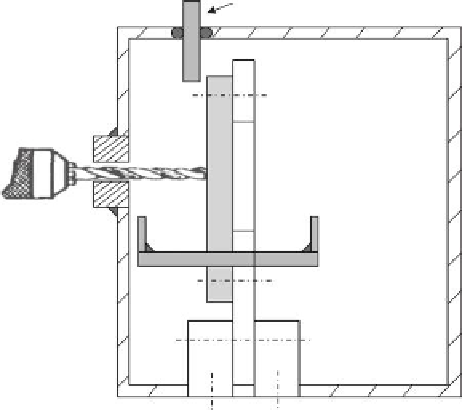Biomedical Engineering Reference
In-Depth Information
Opening for measurement
equipment
Drilling
unit
Sampling tray
Fixture
FIGURE 12.12
Drill chamber for particle collection. (From Sachse, S. et al.,
NanoProduct
Rev
. J., 1, 11, 2013a.)
speeds, with larger drills, and thicker composites. The CNT-alumina composite tends
to generate less airborne particles than the pure alumina sample of the same thick-
ness. On the TEM grids no CNTs could be found (individual or in bundles) in the air
samples and the dust left behind by drilling. Dry drilling of composites did generate a
visible smoke plume (potential exposures to organic thermal decomposition products
of the epoxy components) and wet drilling generated considerably less particulate
exposures.
Sachse et al. (2013a) studied the release of particles during drilling of glass fiber-
polymer composites panels (PA6 and PP) reinforced with nanosilica and microsilica.
The drilling tests of the nano-reinforced panels were conducted in a specially designed
drilling chamber (Figure 12.12). Inside the chamber the panels were mounted on a
fixture. An angle drill (Makita BDA351Z) with a drill diameter of 10 mm and a speed
of 1,800 rpm was used during the tests. Background particle size distribution was
measured before drilling over a period of 1 h. The following drilling was performed
for 14 min. Afterwards, the drill bit was removed and the opening sealed. The actual
measurements were continued for 2.5 h after drilling.
The results showed that drilling generated airborne nanosized particles regard-
less of whether the composite contains nanofillers or not. Furthermore, it could be
seen that the total particle concentration varied significantly depending on the type
of filler and matrix: PA6 panels generated approximately 10 times higher concentra-
tions than that of PP. In another study, Sachse et al. (2012) found that the integration
of nanofillers in the matrix (nanoclay) decreased release rates during drilling. The
test chamber was similar to the one shown in Figure 12.12.
Stahlmecke et al. (2014a) investigated typical handling processes, here drill-
ing, of novel building insulation materials. The materials studied contained typical

Search WWH ::

Custom Search